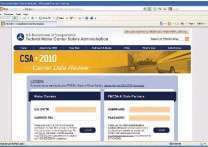FMCSA delays full CSA 2010 rollout
Carriers now have access to data for new program
The Federal Motor Carrier Safety Administration has pulled back on its original plan to implement its Comprehensive Safety Analysis 2010 program in July, but the agency has given motor carriers access to CSA 2010 data so that they can begin working with it before CSA 2010 kicks in later this year.
 Although the new Carrier Safety Measurement System won’t replace SafeStat until Nov. 30, carriers now can view their data as sorted by the Comprehensive Safety Analysis 2010 Behavior Analysis and Safety Improvement Categories (BASICs).
Although the new Carrier Safety Measurement System won’t replace SafeStat until Nov. 30, carriers now can view their data as sorted by the Comprehensive Safety Analysis 2010 Behavior Analysis and Safety Improvement Categories (BASICs).In the April 9 Federal Register, FMCSA said it will replace its Motor Carrier Safety Status Measurement System – commonly known as SafeStat – with an improved Carrier Safety Measurement System on Nov. 30. CSMS is part of the agency’s CSA 2010 initiative. In a housekeeping measure, FMCSA withdrew proposed improvements to SafeStat that it had published for public comment on May 3, 2006.
The new CSMS algorithm “will be able to better identify high-risk motor carriers, make more efficient and effective the agency’s and its state partners’ allocation of compliance and enforcement resources, and provide the motor carrier industry and other safety stakeholders with more comprehensive, informative and regularly updated safety performance data,” FMCSA said in the April 9 notice.
Effective April 12, FMCSA began offering motor carriers a preview of their own CSMS data as sorted by the CSA 2010 Behavior Analysis and Safety Improvement Categories (BASICs). Carriers can review the data by using a PIN number at http://www.csa2010.fmcsa.dot.gov. The preview also will be an opportunity for fleets to update and verify their safety performance data online, FMCSA says.
The preview has limitations, however. The American Trucking Associations says that while the preview includes carriers’ safety events – roadside inspections and crashes – and resulting violations, it does not reflect carriers’ scores in each of the BASICs. Beginning on Nov. 30, motor carriers and the general public will be able to view more complete CSMS data, including scores in each of the BASICs. But the public will not be able to view the Crash Indicator scores because of continued concerns about the quality of the underlying crash data, ATA says. Currently, the accident Safety Evaluation Area (SEA) score in SafeStat – as well as the overall SafeStat score – is withheld from public view for the same reason.
ATA also says that FMCSA on Nov. 30 will begin issuing warning letters to deficient carriers, but will not utilize the full range of CSA 2010 interventions; instead, FMCSA will use CSMS to prioritize motor carriers for standard onsite compliance reviews. For a copy of the Federal Register notice, go to
www.regulations.gov and search FMCSA-2004-18898.
In brief
* The U.S. Department of Transportation and the U.S. Environmental Protection Agency jointly established new federal rules that set the first-ever national greenhouse gas emissions standards. Starting with 2012 model-year vehicles, the rules together require automakers to improve fleetwide fuel economy and reduce fleetwide greenhouse gas emissions.
* U.S. Secretary of Transportation Ray LaHood met with Mexican transportation officials to discuss transportation issues, including establishing a working group to consider avenues for reinstating the cross-border trucking program.
* Daimler Trucks North America and the United Auto Workers struck three-year collective bargaining agreements for DTNA’s truck manufacturing plants in Mount Holly and Cleveland, N.C., and its components and logistics plant in Gastonia, N.C.
* American Trucking Associations Vice President Bob Pitcher said the trucking industry will not support a Vehicle Miles Traveled (VMT) tax. ATA believes federal fuel taxes collected at the pump are the most equitable low-cost method of highway infrastructure funding.
* TNT and Con-way Freight announced a new intercontinental accelerated export service as an expansion of their existing relationship that features a day-definite road/air/road U.S.-to-Europe solution for heavier freight shipments. The offering complements the intercontinental import service the two companies launched in April 2009.
* Arrow Truck Sales and its industry sponsors announced Robert Snyder of Dunnellon, Fla., as the winner of Arrow’s Back On The Road 2010 campaign. Snyder will receive a 2007 Volvo VNL 670, courtesy of Volvo Trucks North America, a one-year work agreement with Heartland Express and other products and services.
Court backs California in TRU restrictions
 Under the Clean Air Act, California has considerable authority to set limits on emissions from in-use nonroad engines such as transportation refrigerated units.
Under the Clean Air Act, California has considerable authority to set limits on emissions from in-use nonroad engines such as transportation refrigerated units.California may continue enforcing its restrictions on transportation refrigerated units as a result of an April 2 ruling by the U.S. Court of Appeals for the District of Columbia Circuit. The court rejected a challenge by the American Trucking Associations and the Truckload Carriers Association to a U.S. Environmental Protection Agency action, allowing the California regulation to move forward.
At issue in the case was EPA’s grant of a waiver to the California Air Resources Board on Jan. 16, 2009, allowing the agency to enforce the TRU regulations, which were adopted in February 2004. The regulations mandate reductions in engine emissions by requiring that TRUs equipped with diesel engines that are seven years old or older be replaced or retrofit with new engines or verified diesel emissions control strategies, or VDECS. Or operators can use alternative technologies such as electric-standby/hybrid-electric or hybrid-cryogenic systems.
CARB originally had planned on the rules taking effect in December 2004, but it needed the EPA waiver to implement them. After receiving the waiver, CARB initially announced a July 16, 2009, enforcement date and eventually delayed enforcement until Dec. 31, 2009. In January and February alone, the agency issued citations totaling more than $180,000 in penalties for failing to register equipment and failing to meet emissions requirements, CARB said recently.
Under the Clean Air Act, California – and California alone – may set limits on emissions from in-use nonroad engines, such as the TRU on a refrigerated truck or trailer. Other states can regulate such engines only if they adopt regulations identical to California’s rules. EPA’s only role is to review California’s proposed rules under a narrowly defined set of statutory criteria. By law, EPA must approve a California in-use nonroad engine regulation unless it finds that the state:
• Unreasonably determined that its rule is at least as protective of public health and welfare as the relevant federal standards;
• Does not need the proposed standard to meet “compelling and extraordinary conditions” in California; or
• Precludes other states from choosing not to regulate or imposes excessive costs.
ATA and TCA challenged EPA’s waiver decision, arguing that the federal agency incorrectly concluded that California needed the specific TRU rule in order to meet “compelling and extraordinary conditions” in the state. The groups also contended that because many trucks throughout the United States must pass through California, the state’s regulation is a “de facto national rule,” effectively precluding other states from choosing not to follow California’s lead. In addition, ATA, which was the lead plaintiff, and TCA argued that EPA failed to consider the cost of compliance appropriately.
The appeals court sided with EPA on all points. EPA concluded that “compelling and extraordinary conditions” refers to the factors that tend to cause pollution – geographic and climatic conditions combined with large numbers and high concentrations of automobiles. “The expansive statutory language gives California (and in turn EPA) a good deal of flexibility in assessing California’s regulatory needs,” the appeals court said. Regarding costs, the court noted that EPA only had to consider costs and that the agency had done so. Businesses can comply for about $2,000 to $5,000 per unit, and the phased implementation would minimize the cost, EPA had found.
The argument that California’s TRU regulations effectively deny other states their right not to regulate is weak because California does not require any state to adopt its approach and because it only applies to vehicles that have entered California, the appeals court said. “If ATA’s members operate trucks in California, they must comply while operating in California. If they do not operate in California, they need not comply. We find nothing about this approach to be inconsistent with the federal statutory scheme,” the court said. The court added that if ATA is concerned that California’s rule unconstitutionally burdens interstate commerce, it could attempt to bring a constitutional challenge directly to the California rule.
The appeals court ruling comes as CARB is considering changes to the TRU regulations. For example, the agency may relax the in-use emissions standards for model year 2003 TRU engines of 25 hp or greater and for model year 2003 and 2004 engines of 25 hp or less. CARB also is considering requirements for electric standby-equipped TRUs to demonstrate they are operated without a diesel engine at all facilities.
FMCSA proposes texting ban
As expected, the Federal Motor Carrier Safety Administration is proposing a detailed, explicit ban on texting by commercial motor vehicle drivers while operating in interstate commerce. The proposal – published April 1 in the Federal Register – would impose sanctions on drivers and would bar motor carriers from allowing their drivers to text while driving.
 The Federal Motor Carrier Safety Administration’s proposal would impose sanctions on drivers and would bar motor carriers from allowing their drivers to text while driving.
The Federal Motor Carrier Safety Administration’s proposal would impose sanctions on drivers and would bar motor carriers from allowing their drivers to text while driving.Drivers convicted of the texting ban two or more times would be subject to temporary disqualification – at least 60 days for the second offense within three years and at least 120 days for three or more offenses within three years. In addition, each violation of the ban would subject a driver to a civil penalty of up to $2,750.
FMCSA’s notice of proposed rulemaking follows regulatory guidance issued Jan. 27 that interprets an existing regulation governing “additional equipment and accessories” to prohibit CMV drivers from using electronic devices to text. The proposed rule would take the guidance a step further by establishing more detailed, binding requirements and would allow the opportunity for comment.
The agency acknowledged in the NPRM that many carriers have invested significant resources in electronic dispatching tools and fleet management systems. “This rulemaking should not be construed as a proposal to prohibit the use of such technology,” FMCSA said. Neither should the proposal be construed as prohibiting the use of cell phones for purposes other than texting, the agency added.
“It is worth noting, however, that while fleet management systems and electronic dispatching tools are used by many of the nation’s largest trucking fleets, the department believes safety-conscious fleet managers would neither allow nor require their drivers to type or read messages while driving. To the extent that there are fleets that require drivers to type and read messages while they are driving, the agency will consider appropriate regulatory action to address the safety problem.”
The NPRM cites recent research commissioned by FMCSA indicating that the odds ratio of being involved in a safety-critical event – such as a crash, near-crash or lane departure – is 23.2 times greater for drivers who engage in texting while driving than for those who do not.
In a regulatory analysis, FMCSA estimates that the annual industrywide cost of the rule is $2.7 million, mostly due to lost driver time. But given that the U.S. Department of Transportation uses $6 million as the value of saving a human life, the rule needs only to save one life a year to be justified, FMCSA said.
FMCSA also announced that it is working with Cornell University to increase public involvement and collaboration in the rulemaking process. In addition to existing venues, the public can participate in the texting ban rulemaking at www.regulationroom.org.
For a copy of the proposed rule, go to www.regulations.gov and search FMCSA-2009-0370.
DOT initiative promotes use of waterways
The U.S. Department of Transportation last month unveiled a new initiative to move more cargo on the water rather than on U.S. highways. Under the “America’s Marine Highway” program, DOT’s Maritime Administration (MARAD) will help identify rivers and coastal routes that could carry cargo efficiently, bypassing congested roads around busy ports and reducing greenhouse gases.
 Under the “America’s Marine Highway” program, the U.S. Department of Transportation’s Maritime Administration will help identify rivers and coastal routes that could carry cargo efficiently.
Under the “America’s Marine Highway” program, the U.S. Department of Transportation’s Maritime Administration will help identify rivers and coastal routes that could carry cargo efficiently.“For too long, we’ve overlooked the economic and environmental benefits that our waterways and domestic seaports offer as a means of moving freight in this country,” U.S. Transportation Secretary Ray LaHood told transportation professionals at the 7th annual North American Marine Highways and Logistics Conference in Baltimore. “Moving goods on the water has many advantages. It reduces air pollution. It can help reduce gridlock by getting trucks off our busy surface corridors.”
Under the new regulation, regional transportation officials will be able to apply to have specific transportation corridors – and even individual projects – designated by DOT as a Marine Highway if they meet certain criteria. Once designated, these projects will receive preferential treatment for any future federal assistance from the department or MARAD.
The Marine Highway initiative stems from a 2007 law requiring the Secretary of Transportation to “establish a short sea transportation program and designate short sea transportation projects to mitigate surface congestion.” Earlier this year, LaHood announced $58 million in grants for projects to support the startup or expansion of Marine Highway services, awarded through DOT’s TIGER grants program. Congress also has set aside an additional $7 million in grants that MARAD will award later this year.
Trucking job market up slightly in March
The for-hire trucking industry gained 600 jobs in March over February, and the job losses for February were revised downward by 1,300, according to the latest seasonally adjusted figures from the U.S. Department of Labor’s Bureau of Labor Statistics.
 PAYROLL EMPLOYMENT IN FOR-HIRE TRUCKING The labor picture for trucking continued to stabilize as the Bureau of Labor Statistics reported that the industry gained 600 jobs in March and lost 1,300 fewer jobs in February than initially thought.
PAYROLL EMPLOYMENT IN FOR-HIRE TRUCKING The labor picture for trucking continued to stabilize as the Bureau of Labor Statistics reported that the industry gained 600 jobs in March and lost 1,300 fewer jobs in February than initially thought.Trucking employment in March was down nearly 64,000, or 4.9 percent, from March 2009. Preliminary data shows payroll employment of almost 1.23 million jobs – down 223,500, or 15.4 percent, from the trucking employment peak in January 2007.
The BLS numbers reflect all payroll employment in for-hire trucking, but they don’t include trucking-related jobs in other industries, such as a truck driver for a private fleet.
Nationwide, the economy gained 162,000 jobs in March, but a large portion of that increase resulted from the hiring of 48,000 temporary workers to conduct the Census.
Navistar drops suit against CARB over SCR
Navistar International Corp. said April 22 that it had withdrawn a lawsuit it had lodged against the California Air Resources Board following an agreement with the state agency to address issues raised in the litigation. The truck and engine maker had asked the San Francisco Superior Court to rule that CARB was improperly certifying 2010 diesel engines equipped with selective catalytic reduction (SCR) aftertreatment because the agency was applying U.S. Environmental Protection Agency certification requirements that permitted SCR-equipped trucks to operate for extended periods without controlling NOx emissions.
Navistar said it had dismissed its lawsuit after reaching an agreement with CARB in which CARB agreed that EPA’s 2009 SCR guidance documents are not its policy. CARB also agreed to hold a public workshop by August to address the issues Navistar raised. Navistar said it believes the workshop will lead to a decision by CARB that SCR-equipped trucks can’t operate with uncontrolled NOx emissions for multiple and lengthy periods of time. “We expect that our agreement with CARB will result in equal enforcement of the 2010 NOx requirements for all engine makers,” says Jack Allen, president of Navistar’s North American Truck Group.
Earlier this month, CARB sided with EPA in Navistar’s ongoing litigation against EPA over its certification of engines with SCR aftertreatment. However, CARB’s grounds for that support – filed April 9 as a so-called “friend of the court” brief with the U.S. Court of Appeals for the District of Columbia Circuit – apparently don’t foreclose the agency’s considerations of certification standards that are tougher than EPA’s guidance.
CARB developed two basic arguments in support of EPA. First, contrary to Navistar’s claim, the 2001 EPA rule that established the 2010 NOx standard did not rule out SCR for compliance. Second, Navistar’s claims that SCR-equipped engines don’t meet the 2001 NOx requirements should be pursued in challenges to the certification of actual engines, not an EPA guidance document.
So in its April 9 filing, CARB didn’t say Navistar was wrong about SCR’s performance; it just said the challenge of EPA’s guidance wasn’t ripe for litigation. “Navistar’s substantive challenge to the policy is a fact-intensive inquiry in a context that is only hypothetical without the actual details of an engine design,” CARB said. “For example, Navistar claims that the policy allows drivers to operate their trucks with empty urea tanks, but only by looking at the certification records can we know if this is true, how long this operation is allowed, what warning and inducements occur, what emissions occur if this is the case, how likely this is to happen, and what enforcement actions will be taken by EPA (and CARB).”
Navistar would not be hurt by having to challenge certification decisions rather than EPA policy, CARB said. “It is the certification decisions that allow Navistar’s competitors to sell engines with SCR systems, not the policy itself. Thus, the policy by itself does not affect Navistar’s ‘day-to-day’ business.”
Meanwhile, the briefing in Navistar’s federal lawsuit is complete, and the case was scheduled for a hearing before the appeals court on May 10.
–Avery Vise
Fuel savvy
Bill could help fleets better manage fuel costs
ATA, state associations back Senate effort to address unregulated derivatives markets
For carriers seeking less volatility in fuel prices to better manage costs, help may be on the way. On April 21, the Senate Agriculture Committee marked up The Wall Street Transparency and Accountability Act of 2010 in an effort to “clean up shadowy and unregulated derivatives markets.” The bill proposes mandatory clearing and trading requirements, real-time reporting of derivatives trades and closing all loopholes. The full bill text can be seen at http://www.ag.senate.gov/site/legislation.html.
 A reduction in fuel price volatility lowers fleets’ exposure to fuel price spikes and helps carriers purchase fuel at the lowest possible cost through strategies such as collective purchasing and hedging.
A reduction in fuel price volatility lowers fleets’ exposure to fuel price spikes and helps carriers purchase fuel at the lowest possible cost through strategies such as collective purchasing and hedging.“Through passage of this legislation, America’s consumers and businesses will finally see a financial oversight system that promotes and fosters more honest, open and reliable financial markets in the world,” says Senate Agriculture Committee Chairman Blanche Lincoln (D-Ark.), who introduced the bill.
The bill’s announcement was applauded by the American Trucking Associations, who in March – along with 16 state trucking associations as part of the Commodity Markets Oversight Coalition – called on Washington to pass legislation for federal regulation of the commodity futures market.
In 2008, excessive speculation in commodities was blamed for creating an energy bubble that led to crude oil prices reaching $147 per barrel. ATA says fleets spent $146 billion on fuel in 2008, a 32 percent increase from the previous year and more than double what the industry spent on fuel in 2004.
“The legislation will help ensure that fuel prices are linked to the market forces of supply and demand,” says ATA Vice President Rich Moskowitz. “Increasing transparency and setting position limits while preserving the ability of commercial entities to hedge fuel purchases will strengthen the link between commodity prices and market fundamentals.”
A reduction in fuel price volatility lowers fleets’ exposure to fuel price spikes and helps carriers purchase fuel at the lowest possible cost through strategies such as collective purchasing and hedging. n
– Jeff Crissey











